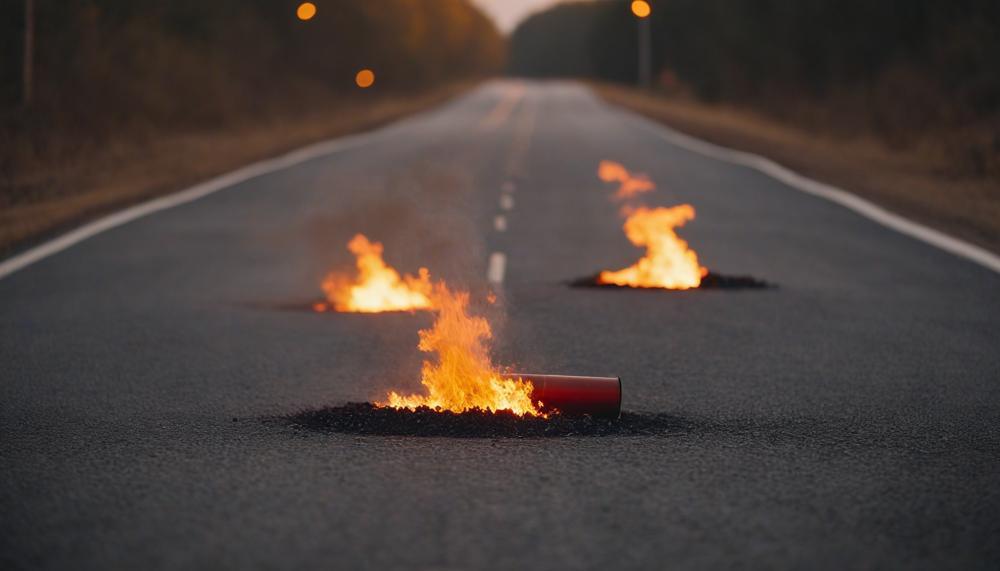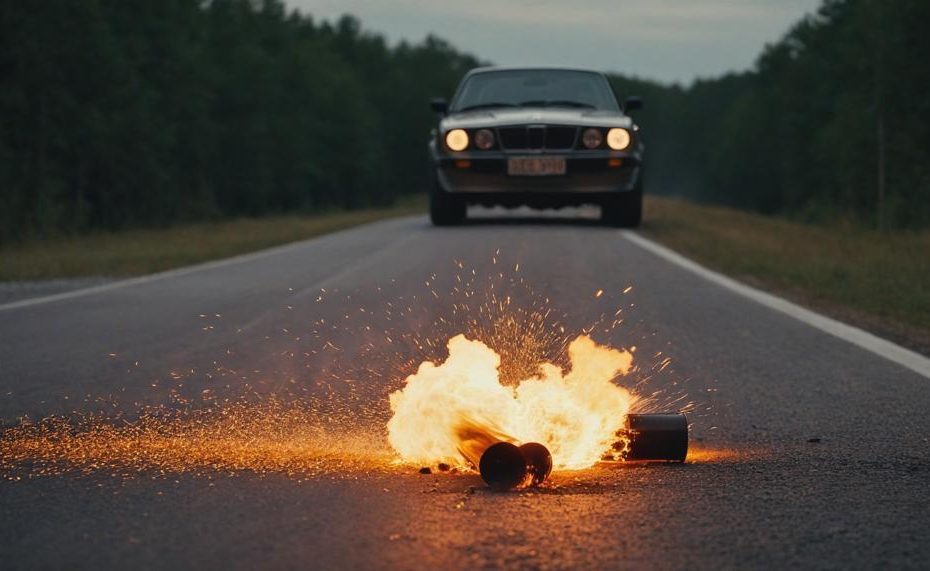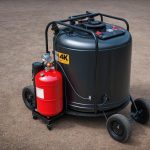Disposing of road flares properly is crucial for environmental safety and public health. Road flares contain hazardous materials, including sulfur and potassium nitrate, which can pose significant risks if not handled correctly.
Many people may not realize the potential dangers associated with improper disposal, such as toxic fumes or chemical reactions. To ensure safety and compliance with environmental regulations, it is essential to follow specific steps when disposing of these devices.
Here are the key takeaways for proper road flare disposal:
- Yes: Always dispose of road flares at a hazardous waste facility. These facilities are equipped to handle and neutralize hazardous materials safely.
- No: Do not throw road flares in regular trash or leave them in a landfill. This can lead to environmental contamination and potential health hazards.
- Expiration Check: Check the expiration date on your road flares. Expired flares should be disposed of immediately to prevent instability and danger.
- Soak in Water: If you cannot access a hazardous waste facility, soak the flares in water for at least 24 hours to deactivate the chemicals.
- Wrap and Label: After soaking, wrap the flares in newspaper or place them in a sealable plastic bag, label them as “hazardous waste,” and store them in a safe, ventilated area until they can be properly disposed of.
Understanding these steps not only protects you but also contributes to a safer environment. Proper disposal of road flares ensures that hazardous chemicals do not harm wildlife, pollute the soil, or contaminate water supplies.
Taking these precautions helps maintain public safety and environmental health, making responsible disposal practices an essential part of using road flares.
Contents
How to Dispose of Road Flares
Disposing of road flares correctly is vital for safety and environmental protection. Follow these steps to ensure proper disposal:
Check Local Regulations
Perform an online search to determine if your state or county laws allow for disposal as household hazardous waste. Laws vary, so always verify the appropriate method.
Contact Hazardous Waste Facility
If allowed, contact your local household hazardous waste facility. These facilities are equipped to handle and dispose of hazardous materials safely.
Contact Manufacturer
If your local laws do not allow disposal at a hazardous waste facility, contact the manufacturer for guidance on safe disposal methods.

Do Not Throw in Garbage
Never dispose of road flares in regular garbage. They pose fire, health, and environmental hazards.
Proper Storage Until Disposal
Store expired flares in a separate container labeled “expired flares.” Ensure the plastic cap and removable lid are securely in place. Keep them away from heat sources or electrical systems that pose a fire risk.
Regular Inspection
Regularly inspect the storage compartment to ensure all flares are securely capped and clean any residue to prevent fires.
Why You Should Not Throw Road Flares in the Garbage
Proper disposal of road flares is vital due to several significant risks associated with improper handling. Here are the key reasons why you should not throw road flares in the garbage:
- Fire Hazard: Road flares contain highly combustible materials. If thrown in the garbage, they can easily ignite, leading to potential fires in waste collection vehicles or landfills.
- Environmental Impact: The chemicals in road flares can be harmful to the environment. When disposed of improperly, these chemicals can leach into the soil and water systems, causing pollution and posing risks to wildlife and human health.
- Legal Requirements: Many local and national regulations mandate specific disposal methods for hazardous materials like road flares. Ignoring these regulations can result in legal penalties and fines.
- Public Safety: Improper disposal of road flares can pose safety risks to waste management workers and the general public. Accidental ignition during handling can cause severe injuries.
To ensure safe and responsible disposal of road flares, consider the following steps:
| Step | Description | Details |
| Check Local Regulations | Understand specific disposal guidelines | Consult your local government’s waste management policies to know the exact disposal procedures. |
| Contact Hazardous Waste Facilities | Reach out to specialised disposal services | Hazardous waste facilities are equipped to handle dangerous materials like road flares safely. |
| Manufacturer Guidelines | Follow manufacturer instructions | Refer to the product manual or contact the manufacturer for recommended disposal methods. |
| Regular Storage Inspection | Ensure safe storage before disposal | Regularly inspect your stored road flares to ensure they remain in a safe condition until disposal. |
Do Road Flares Expire?
Yes, road flares can expire. The effectiveness of road flares typically ranges from 2 to 4 years, depending on the brand and type. It’s essential to check the expiration date marked on the flare to ensure they are replaced as needed.
Expired flares might not ignite properly or burn for the intended duration, which can compromise safety during emergencies.
| Brand/Type | Expected Lifespan | Notes |
| Standard Road Flares | 2-4 Years | Check expiration date regularly. |
| High-Quality Brands | Up to 5 Years | May last longer but still need inspection. |
| LED Flares | Indefinite (Battery life dependent) | Replace batteries as needed. |
When flares expire, dispose of them safely by following local regulations and consulting hazardous waste facilities. Proper disposal prevents environmental harm and safety risks.
Handy Tips for Storing Road Flares Safely
Safe disposal of road flares is crucial to avoid environmental harm and ensure public safety. Here are some recommended methods:
| Method | Description | Precautions |
| Hazardous Waste Facility | Take road flares to a local hazardous waste disposal site. | Contact local waste management for facility locations. |
| Collection Events | Participate in city-organized hazardous waste collection days. | Check local government websites for event dates. |
| Flare Recycling Programs | Engage in programs that recycle flare components. | Ensure the program is certified for safe recycling. |
| Soaking and Wrapping | Soak flares in water, wrap in newspaper, label as hazardous waste, and store safely. | Soak for at least 24 hours to deactivate chemicals. |
Safety Tips to Remember When Using Road Flares
When handling and disposing of road flares, ensuring proper disposal is essential to prevent accidents and protect the environment. Here are key safety precautions to follow:
| Safety Precaution | Description |
| Avoid Ignition Sources | No smoking or open flames near road flares. |
| Clear Flammable Materials | Ensure the area is free of flammable materials. |
| Proper Disposal Methods |
|
| Alternative Disposal at Home |
|
| Handling with Care |
|
By adhering to these guidelines, the risk of fires, injuries, and environmental harm can be significantly minimized.
Conclusion
Proper disposal of road flares is imperative for safeguarding both our environment and public health. Road flares contain hazardous chemicals like sulfur and potassium nitrate, which pose serious risks if not managed correctly. Many people are unaware that improper disposal can lead to toxic fumes or dangerous chemical reactions. To ensure safety and adhere to environmental regulations, follow these key steps:
First, always take expired road flares to a hazardous waste facility. These centers are equipped to neutralize hazardous materials safely, preventing environmental contamination and health hazards. Throwing flares in regular trash or landfills is a severe risk and can lead to significant pollution.
If access to a hazardous waste facility is unavailable, deactivate the flares by soaking them in water for at least 24 hours. After soaking, wrap them securely in newspaper or place them in a sealable plastic bag, label as “hazardous waste,” and store in a safe, ventilated area until proper disposal can be arranged.
By diligently following these procedures, you protect yourself, others, and the environment from the harmful effects of improperly disposed road flares.





